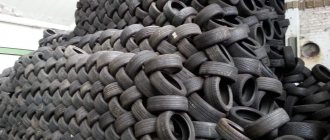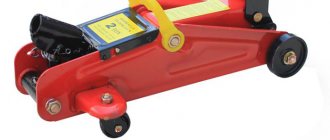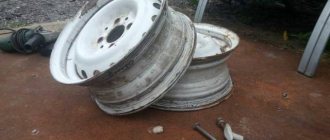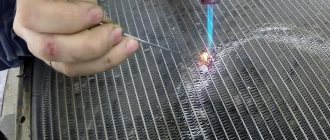How to make crumb rubber with your own hands - methods, features
Due to the increase in the number of road transport, the amount of waste began to increase exponentially, so the environmental situation was under great threat. Every year, thousands of tires are taken to landfills and landfills, where they become a source of negative impact on the entire environment.
Car tires are classified as hazardous waste class 4, since during the decomposition process they release carcinogenic and toxic substances that can destroy the shell of the biosphere. Over the past few years, recycling requirements have become more stringent (especially in large cities), and compliance with the method of recycling rubber products is also regularly monitored.
Tire material composition
A tire consists of many materials that differ in their physical and chemical properties.
- Steel - the cord and spikes are made from it.
- Hydrocarbons are artificial rubber with a carbon black filler.
- Sulfur in vulcanizing additives.
- Synthetic thread - cord is also made from it.
- Chlorine-containing hydrocarbons in the adhesive.
Harmful substances such as arsenic and lead are not added to modern tires.
Car tire
In order to completely recycle all these various substances and not cause damage to the environment, designers and technologists have developed several technological processes and installations that serve them.
Marketing
Develop a strategy to promote your product. Use these methods:
- Creation of a business card website. The Internet is now the most convenient way to obtain information. Develop a website, fill it with useful information.
- Direct work with consumers. Explore the industries that use rubber granulate. Work directly with organizations. Send proposals by email, organize personal meetings with their representatives, and conduct negotiations.
- Sales through trade and retail chains of construction stores.
- Outdoor advertising on city billboards, publication of advertisements in newspapers.
Tire pyrolysis
The simplest reuse process is to use waste tires as fuel. Recycling tires by burning them in the open air or in furnaces is unacceptable, since open combustion produces a lot of air pollutants and substances harmful to health.
Diagram of the pyrolysis installation
Therefore, combustion is carried out in pyrolysis plants in two stages.
At the first stage, under conditions of lack of oxygen at high temperatures (up to 500 ° C), materials decompose into pyrolysis gas, liquid hydrocarbons, soot and solid metal residues. With the correct settings of the process parameters, from one ton of feedstock the following is obtained:
- 0.5 tons of liquid hydrocarbons that can be purified to obtain usable gasoline;
- 200 kg of gas used to heat the pyrolysis unit;
- 200 kg of soot (carbon);
- 100 kg of steel.
Pyrolysis gases contain sulfur and silicon oxide.
Tire pyrolysis plant
The soot resulting from the process is unfortunately highly contaminated with chlorine and sulfur compounds, as well as extremely toxic dioxins. It is impossible to use it as a raw material for carbon production. Cleaning from harmful impurities is too expensive. Disposal of such waste is possible only with the support of government environmental programs for the recycling of car tires and other hazardous waste.
Raw materials
This is the main item of monthly expenses - you will regularly need to purchase large volumes of used vehicle tires and tyres. They are not difficult to find. The number of cars in Russia is constantly increasing, as is the volume of consumption of rubber products. It is important to get them - Russia has not developed a system for collecting and recycling this waste.
There are several ways to purchase raw materials - buy by advertisement, organize a collection point yourself, or pick up tire waste in places where it accumulates (at tire shops and trucking companies, at landfills and quarries, at unauthorized landfills).
If you have a large-scale production, it is better to start cooperation with companies that can offer the required volume of raw materials.
Used tires, tires, air chambers, old fabric or reinforced rubber are suitable for production.
Grinding tires to obtain rubber crumbs
The recycling principle is very simple. Tires are crushed on special equipment for processing tires into crumbs in several stages, the resulting product is sorted, and at the output of the production line three materials are obtained:
- metal in the form of small wire scraps;
- rubber crumb;
- cord thread trimmings.
The process of turning tires into crumbs
In this case, no chemical changes occur in the materials, and all harmful compounds remain in a bound, stable state, and no new ones are formed. Processed products can be safely stored and transported.
If metal waste can be easily separated from crumb rubber, then certain technical difficulties arise in isolating from its composition a polymer thread that is similar in chemical and physical properties.
Therefore, budding entrepreneurs in environmentally oriented businesses work, as a rule, with purely metal-cord tires. Tire Recycling Machine The main problems they face are:
- Selecting a location for installing equipment.
- The alternative between erecting a new building or adapting an existing one.
- Selection, purchase and installation of machines for tire processing.
- Registration of permits for the disposal of car tires.
- Development of sustainable supply channels for raw materials and sales of the final product.
The simplest machine for processing tires is not that expensive, but it has limited productivity and the size of the processed raw materials. The use of other grinding methods removes these limitations, but increases the cost of the line.
Staff
It is not necessary to hire expensive qualified specialists. You need to hire the following employees:
Table 2. Personnel to work at a mini plant for the production of crumb rubber.
| Job title | Main responsibilities |
| Workers, 3 people. | Maintenance of equipment, control of its operation |
| Loaders, 2 people. | Loading and unloading, supply of raw materials, storage of finished products |
| Technologist, 1 person. | Monitoring the operation of equipment and production technology, troubleshooting |
| Sales Manager, 1 person. | Working with suppliers, searching for sales channels |
| Driver, 1 person | Logistics, delivery of goods to consumers |
| Accountant, 1 person | Maintaining accounting records |
| Director, 1 person | Management and control of the entire operation of the enterprise |
The director can be the businessman himself. A technologist and accountant can be outsourced, and a driver can be provided with your own car.
Equipment for processing tires into crumbs
This group of equipment is designed for grinding raw materials into crumbs and dividing them into fractions with subsequent shipment for further processing.
Vibrating screen for sorting
A typical set of equipment for tire recycling includes:
- Group of shredders (shredder, hydraulic shears, tape cutter).
- Waste separators (magnetic and vortex).
- Conveyors for moving raw materials.
- Vibrating sieves for sorting.
- Equipment for packaging and loading of products.
- Low-power pyrolysis plant for burning textile waste.
The price of such a turnkey line starts at 10-15 million rubles. However, it is not necessary to purchase all equipment from one brand. Using locally produced machines and devices with similar technical characteristics (or simply those already available) you can save significantly.
Before purchasing, be sure to visit a similar operating enterprise and find out from them the problems and bottlenecks when using this or that equipment.
The most important component of the production line will be the shredders. Their smooth and uninterrupted operation largely determines the production and financial success of the enterprise.
Tire recycling begins with a shredder, which cuts tires into fragments no larger than 15-20 cm in size. It bears the maximum load, so it would be wise to take care of a good service contract and a supply of spare parts.
Tire Shredder
If the planned output exceeds a ton of tires per hour, it is better to choose a multi-roll plant made in Europe. Its high-quality work will facilitate the functioning of equipment located further in the technological chain.
Rotary knife crushers and cam extruders are used as secondary crushers. Extruders are inexpensive to purchase, but come with high operating costs for electricity and replacement of failed cams.
Conveyors, separators and vibrating sieves are simple in design and do not have such highly loaded and critical parts. Many local manufacturers produce such tire recycling equipment at affordable prices, while maintaining high quality products.
Market analysis
Currently, the business of recycling used tires is rare. There are very few similar factories throughout the country. The issue of environmentally safe disposal is quite acute.
Tire recycling business analysis
Operating factories cannot cope with large volumes of raw materials. According to statistics, about 8-11 tons of used tires appear every year. Currently, about 65% of the total volume of used tires in Russia is recycled by 4 large plants located in the Moscow, Smolensk, Vladimir and Volgograd regions.
Since the processing of automobile rubber into secondary raw materials occurs at a certain cost for the owners of old tires, motorists have no motivation to hand over tires for recycling. Therefore, large volumes of used tires remain unrecycled. Thus, the business of recycling used tires for recycling is very relevant.
Fuel production line
From a business point of view, becoming a pure fuel producer is profitable and prestigious.
The energy potential of one ton of tires is approximately equal to the potential of a ton of coal. But there is a big problem standing in the way of the successful use of waste tires: the toxicity of combustion products. They contain sulfur dioxide, dioxins and other highly toxic compounds.
Tire to fuel processing line
Burning over an open fire is unacceptable; in the case of a pyrolysis installation, the issue of processing toxic waste remains. The installation will have to install expensive treatment facilities. With them, the process can become profitable provided that at least 110 tons of raw materials are processed per day. Investments will pay off rather slowly. Most of these installations were built with government support or with government participation.
There is another technological process. In plants of this type, tires are processed into fuel. The complex requires about 20 m2 for installation, its height is 10 m. Metal rims are removed from former tires, crushed into crumbs and loaded into a chemical reactor using a conveyor. It maintains an operating temperature of 460 °C. Under such conditions, rubber breaks down into liquid hydrocarbons, pyrolysis gas, solid soot deposits and metal scraps. This gas is used to maintain the temperature in the reactor; its excess, in small quantities, is released into the atmosphere after passing through the purification system.
Liquid fractions are poured into containers through a dosing system and taken to a warehouse. Soot waste (carbon black) is cooled, quenched and metal is separated on magnetic separators. Metal, carbon and waste are also packaged and sent for sale and disposal.
Such a system processes up to five tons of tires into fuel per day. This gives:
- liquid fuel fractions - up to 2 tons;
- metal waste - up to 0.5 tons;
- solid carbon-containing residues - up to 1.5 tons;
- gas - up to 1 ton.
The tire recycling line is installed outdoors under a canopy and requires a level area with a hard surface. Production maintains a continuous work cycle and requires two operators per shift to operate. Electric power - up to 15 kW. Air and industrial wastewater purification systems will also be required.
Oven operation
The operating method of an industrial pyrolysis plant for processing rubber products and tires involves several main production stages:
- Preparation of material for its further decomposition in a retort.
- The resulting raw material during pyrolysis is fed into a device for cooling and partial condensation of the pyrolysis gas.
- When passing through the condensing pipeline, the final separation into liquid and gaseous components occurs.
- When the remaining gas is dried, it is supplied for further combustion in a furnace.
Large processing plants use additional catalyst units in the rubber decomposition process.
In our country, the method of technological rubber processing is not yet widely used, but worthy examples of domestically produced plants are available on the market.
The rapid development of the automotive industry and the availability of cars leads to the fact that the number of used tires is growing every year. The accumulation of tires has a negative impact on the environment, since this kind of waste practically does not decompose naturally in nature and therefore cannot simply be buried in special landfills. To avoid a man-made disaster, unnecessary tires should be disposed of.
There are several methods for recycling unnecessary tires, but the most promising and environmentally correct method is considered to be pyrolysis, implemented in special installations (pyrolysis ovens).
Schematic diagram of a pyrolysis furnace with main elements











